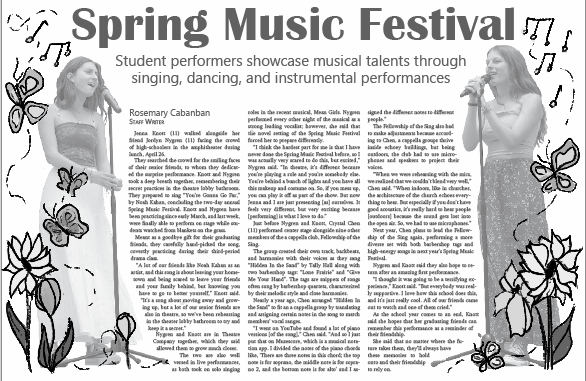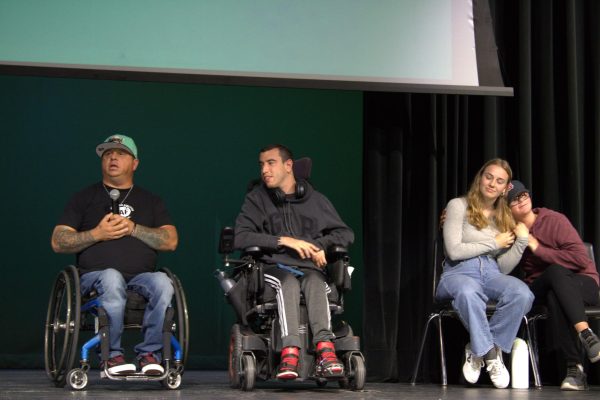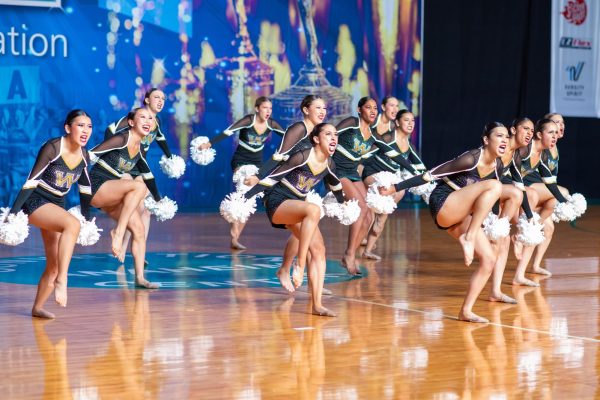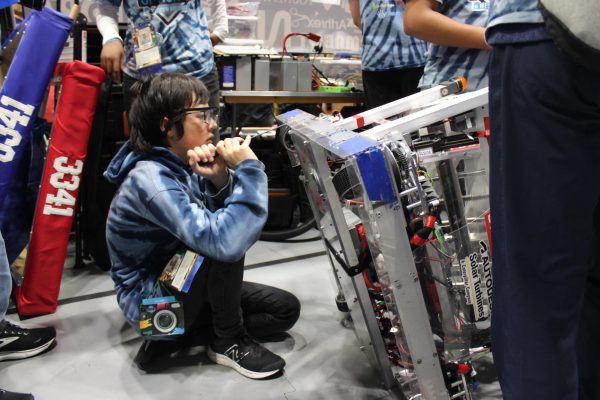Winter Guard blooms in competition
March 18, 2022
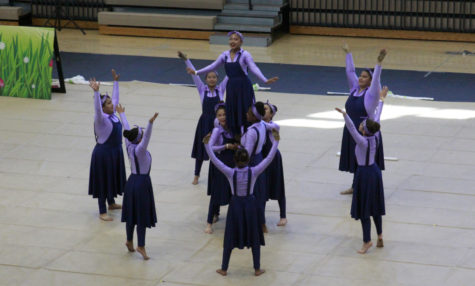
Team captain Ella Cuevas (12) stood in a circle with her teammates, hands interlocked. As they waited anxiously to hear themselves called up to go on stage, the entire group inhaled together, then exhaled. And again. Inhale. Exhale.
As before previous performances, this pre-show ritual allowed the team to breathe out their worries and feel more confident while performing.
After their last breathing exercise together, the team gathered up their props and told each other to have a good show. They waited for the announcer to bring them out.
Winter Guard competed against 40 other schools with their routine, “A Beginner’s Guide to Gardening” on March 12 at Mission Hills High School. They placed second overall, only 0.01 points away from first place.
After growing as a team throughout the year, Cuevas said that she loves watching the newer team members improve their skills.
“It’s really amazing to see them grow,” Cuevas said. “I’m super proud of them.”
Cuevas is now in her fourth season on the team. Her main role as captain is to assist with communication, but she also goes above and beyond to help out her teammates.
“I am like a liaison between my coaches, my team, the band president, and Mr. Way,” Cuevas said. “I am also the social media manager so I update our Facebook and Instagram. I try to help the girls out as much as possible. During COVID, I even started a tutoring program for underclassmen [on the team].”
An element of solidarity and kinsmanship is one that motivates Winter Guard members. Valerie Hsu (9) is in her first season on the team and became interested after seeing Westview’s team perform at Mesa Verde. The thing she looks forward to most about practicing with the team is the community she forms with her teammates
“Preparing for competitions is really fun to me because it makes you feel like you’re part of something bigger,” Hsu said.
For Cuevas, the family and community aspect of Winter Guard is the thing she looks most forward to. She said that the best thing about practices is being with people who are no longer just her teammates, but also her friends.
“We’re always there for each other no matter what,” Cuevas said. “I always look forward to the random conversations we have. It’s great that all of us have a relationship outside of the team and outside of school.”
Although the atmosphere of Westview’s Winter Guard isn’t very competitive, Cuevas said that the motivation of winning competitions helps her to improve.
“I like the competition side because it pushes me to do better and motivates me to keep on practicing and keep doing better at every show,” Cuevas said.
The routine they performed at the competition on March 12 differed greatly from previous field routines as it had a focus on artistry rather than endurance.
With such a distinct theme, it was important for the team to find unique ways of reflecting and highlighting it. To convey the gardening theme, the team used specifically themed props and symbolically represented flowers through their dancing.
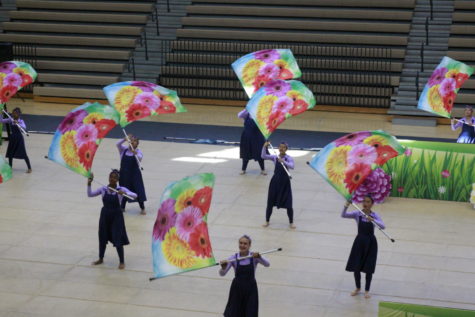
“We are using flower umbrellas, grass backdrops, shovels, and a big seed bag,” Hsu said. “We also have new flags that are water and grass themed. Plus, in the beginning, we lift one of the girls because she is the center of the flower.”
With this new focus on artistry, the team had to work hard to adapt and best showcase their skills for competitions.
“It’s difficult but in a different way,” Hsu said. “During the field season, the show is longer and you have to travel around the field, so it’s more endurance-based. But for Winter Guard, you can do more challenging tricks and choreography.”
Hsu said that despite the possibility of mistakes, the team tries to iron out the wrinkles in the performance in advance to ensure that everything goes as smoothly as possible.
“It’s challenging, but it’s manageable,” Hsu said. “The worst thing that can go wrong is someone placing their equipment wrong so they don’t have what they need at a specific time. But, we’ve talked about all these things as a team and now we know how to handle it.”
Because the routine uses a variety of different props, it can be difficult to keep everything coordinated. After making a mistake, the performers must quickly jump back into the choreography without missing a beat.
“There are parts where it’s harder to get back in,” Cuevas said. “The best thing that I tell the girls to do is to count and look at the people around them so that it doesn’t look like a hole in the show. But drops happen, it’s inevitable. We’re all human.”
Throughout the routine, it’s paramount that the team stays in sync. They work hard during practices to make sure that they dance together cohesively as a whole group.
“When we’re practicing, we go count by count cleaning every angle,” Cuevas said. “We’ll take one section of our show and just work on it the entire hour to make sure we’re together and synchronized.”
To stay on the same counts, Cuevas said that they count out loud or in their heads and use the music.
“This year, our show has a weird tempo,” Cuevas said. “So there are definitely some parts that we have to count out loud together and there are also some parts where we need the music instead of counting.”
Hsu mentioned that though she usually feels some nerves before performing, the excitement of competing outweighs these feelings and allows her to perform to the best of her ability.
“It’s natural to be nervous at the beginning, but once the music starts playing, you focus on your choreography and your performance,” Hsu said. “The nerves kind of slip away.”
According to Cuevas, countless hours of practice and a rush of adrenaline allow her to perform without needing to think about every step.
“When I look back on it, I’m not really thinking when I’m performing because it’s just muscle memory,” Cuevas said. “I do my best to count in my head but sometimes I get lost in what my body’s doing.”
After four years of performing with the Color Guard, Cuevas said that she is now less nervous about competing and can take in the experience more.
“When I first started as a freshman, I would always get nervous before I was about to perform,” Cuevas said. “Performing in front of others was always really scary. But since I’ve done Color Guard for such a long time now, I have learned how to deal with those nerves and now I can enjoy performing more.”



